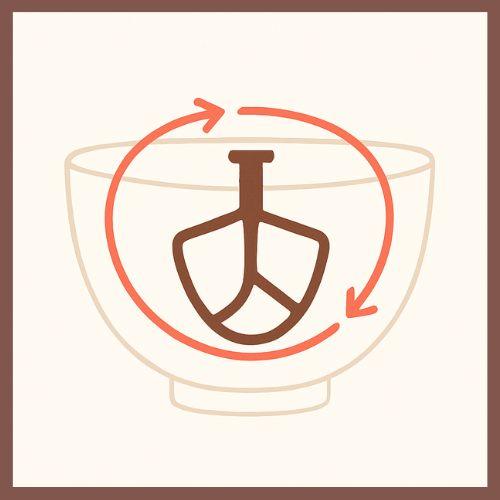Notice: I receive compensation if you buy something through affiliate links on this post. This does not change the price you would pay.

Planetary mixing is the mixing system used in most modern stand mixers where the beater spins on its own axis while orbiting the bowl—like a planet around the sun. This dual action ensures even, thorough mixing. It gives more consistent results across batters, doughs, and frostings.
If you, like me, have ever used one of those small stand mixers with two beaters spinning in the middle of the bowl, you know they never quite reach the ingredients along the wall.
It’s frustrating to keep scraping down the sides, nudging unmixed flour or butter back to the center.
The solution? Planetary mixing — a smart design found in modern stand mixers that are bigger, stronger, and more efficient.
Head-scratching? What do ‘planets’ have to do with baking?
You’ll learn exactly that in the next sections.
Let’s take a closer look and break down how planetary mixing works.
Contents
What Is Planetary Mixing?
Planetary mixing is a system wherein your stand mixer attachments reach every part of the bowl.
The beater doesn’t just spin — it rotates on its own axis while traveling around the bowl, just like a planet revolving around the sun.
That’s why it’s called planetary: two motions happening at once — a spin and an orbit — ensuring all ingredients are swept into the mix.
For a clear visual, KitchenAid’s explanation of how stand mixers work illustrates this motion beautifully.
How Planetary Mixing Works
Inside a planetary mixer, the attachment spins on its axis while the mixer head moves that attachment around the bowl.
This dual motion eliminates “dead spots.” Every corner and edge of the bowl is covered, so you spend less time scraping and more time doing other baking tasks.

Planetary Mixer Design & Key Features
Most modern stand mixers — from KitchenAid tilt-heads to heavy-duty bowl-lift models — use a planetary design.
Here’s what defines it:
- Single-beater system – one attachment moves around the bowl for full coverage
- Interchangeable attachments – flat beater, dough hook, and whisk for different tasks
- Stable, solid housing – ensures consistent motion and less wobble even at high speed
What Is a Planetary Mixer Used For?
Planetary mixers are all about versatility. You can use them for:
- Cakes, cookies, and cupcakes
- Whipped cream, frosting, or buttercream
- Mashed potatoes and other sides
Can they handle bread dough?
Yes, light to medium doughs are fine. For dense or frequent bread baking, though, a spiral or dough mixer is better equipped for the job.
If you’re exploring which model suits your baking style, Food Network’s best stand mixers of 2025 offers a solid roundup of options.
Planetary Mixer vs Other Mixing Systems
Planetary Mixer vs Spiral Mixer
| Feature | Planetary Mixer | Spiral Mixer |
|---|---|---|
| Mixing Motion | Beater spins and orbits around the bowl | Hook and bowl rotate together |
| Best For | Cakes, cookies, frostings, and light dough | Bread, pizza, and heavy dough |
| Versatility | Multiple attachments for various recipes | Primarily designed for kneading dough |
| Ease of Use | Compact, simple for home bakers | Bulkier, commercial-friendly design |
| Mixing Bowl | Stationary during mixing | Rotates with the spiral hook |
If you do a bit of everything, go planetary. If you’re a bread lover, spiral is your friend.
Advantages of Planetary Mixing
- ✅ Even mixing – no flour pockets or unmixed streaks
- ✅ Efficiency – faster, smoother blending
- ✅ Versatility – one system handles multiple tasks
- ✅ Consistency – reliable results every time
Planetary mixers deliver the same perfect mix, batch after batch.
A Small Revolution in Every Rotation
Quizzical brows when you first read about planetary mixing? I bet they’ve relaxed by now.
You’ve discovered what planetary mixing action means, why it matters in baking, and how it changes the way your stand mixer performs.
You’ve also learned how it brings results — even batters, fluffy frostings, and doughs that come together with less effort.
So now the real question is: does a planetary mixer fit your baking style? If you value convenience, consistency, and that smooth, no-scrape finish, you already know the answer.
If you’re ready to take the next step, here are two excellent options for home bakers to explore.
